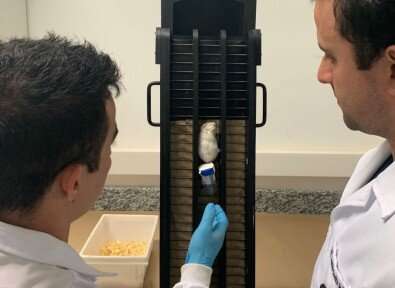Study shows that strength and weight training can control diabetes in obese individuals

Research conducted at the University of Campinas (UNICAMP) in São Paulo State, Brazil, shows that vigorous physical exercise such as strength and weight training can reduce accumulated liver fat and improve blood sugar control in obese and diabetic individuals in a short time span, even before significant weight loss occurs.
In experiments with mice, researchers at UNICAMP's Molecular Biology of Exercise Laboratory (LaBMEx) found that two weeks of such exercise was sufficient to modify gene expression in liver tissue in ways that "burned" more stored lipids and contributed to the treatment of nonalcoholic fatty liver disease. Cellular insulin signaling in tissue improved, and hepatic synthesis of glucose decreased.
The results of the study, which was supported by São Paulo Research Foundation—FAPESP, are published in the Journal of Endocrinology.
"Everyone knows physical exercise helps control disease. Our research focuses on how and why this is so, on the mechanisms involved. If we can discover a key protein whose levels rise or fall with training, we'll have taken a step toward the development of drugs that mimic some of the benefits of physical exercise," said Leandro Pereira de Moura, a professor at UNICAMP's School of Applied Sciences and the principal investigator of the study.
Moura explained that excess fat in the liver causes local inflammation, which makes liver cells less sensitive to the action of insulin. This condition can progress to cirrhosis and eventually to liver failure.
"In obese individuals at cardiometabolic risk, reducing liver fat is vital to help control diabetes," Moura told. "The liver should produce glucose only under fasting conditions, but if insulin signaling in tissue is impaired, the liver releases glucose into the blood stream even after ingestion of carbohydrate, when insulin levels are high, and this raises the level of blood sugar."

Strength training for mice
To investigate the effect of strength training on the liver, an experiment involving three groups of mice was performed. The control group, which was fed a standard diet (4 percent fat), remained lean and sedentary. The second and third groups were fed a hyperlipidemic diet (35 percent fat) for 14 weeks, long enough for the animals to become obese and diabetic. The second group remained sedentary, while the third group was submitted to a moderate strength training exercise protocol for 15 days after becoming obese and diabetic.
The exercise protocol consisted of climbing a staircase with a weight attached to the tail. Each day, the mice climbed the stairs 20 times at 90-second intervals. According to Moura, the protocol was designed to mimic strength training in humans.
"Before we began the experiment, we conducted tests to determine the maximum load each animal could bear. We used a weight corresponding to 70 percent of this limit in the exercise sessions. Our group had previously shown overtraining can contribute significantly to the development of nonalcoholic fatty liver disease. Excessively strenuous exercise can do more harm than good," Moura said.
The researchers opted for a short exercise protocol of only 15 days to demonstrate that the benefits observed were directly linked to strength training and not to the secondary effects of weight loss.
In fact, the researchers found that although the mice submitted to exercise training were still obese at the end of the 15-day period, their fasting blood sugar levels were normal, whereas the mice in the sedentary obese group remained diabetic until the end of the experiment.
An analysis of liver tissue showed a 25%-30% reduction in local fat in the group that performed the exercise protocol compared with the fat level of the sedentary obese group. The quantity of proinflammatory proteins was also reduced in the exercise group, and yet the mice in that group still had approximately 150% more liver fat than the control group.
Gluconeogenesis
In fasting conditions, the liver is the main organ responsible for maintaining adequate blood sugar levels. In the context of diabetes, control of gluconeogenesis (endogenous glucose production) is absent as a result of insulin resistance, and the individual can become hyperglycemic.
To evaluate the effect of strength exercise on the control of hepatic gluconeogenesis, the researchers tested the animals for tolerance of pyruvate, the main substrate used by the liver to produce glucose.
"The test consisted basically of administering pyruvate to the mice and measuring the amount of glucose produced by the liver," Moura explained. "We found that the trained mice produced less glucose than the sedentary obese mice even though they received the same amount of substrate. This showed that the trained animal's liver underwent metabolic alterations that made it more sensitive to insulin."
Next, the researchers investigated the mechanism by which exercise reduced liver fat. To do this, the researchers analyzed the tissue expression of genes associated with lipogenesis (synthesis of fatty acids and triglycerides, contributing to the accumulation of fat) and lipolysis (breakdown of lipids for use as an energy source by the organism).
"We compared the sedentary obese mice with the exercised mice by means of gene and protein analyses to evaluate the synthesis and oxidation of liver fat," Moura said. "We observed a tendency towards more liver fat accumulation in the sedentary mice."
He added that an important contribution of the study was its demonstration that strength exercise promoted beneficial alterations in tissue that was not directly acted upon by skeletomuscular contractions.
"Our next step will be to find out how this communication between muscles and liver is processed. Our hypothesis is that a protein called clusterin may be involved," he said.
If the rise in clusterin levels induced by physical exercise is shown to be beneficial, Moura said, treatments with synthetic alternatives could be tested.
More information: Rodrigo Martins Pereira et al, Short-term strength training reduces gluconeogenesis and NAFLD in obese mice, Journal of Endocrinology (2019). DOI: 10.1530/JOE-18-0567



















